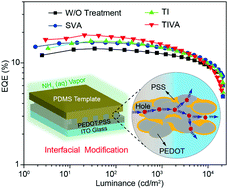Thermal imprinting and vapor annealing of interfacial layers for high-performance organic light-emitting diodes†
Abstract
Control of interfacial layers is highly effective in tuning charge injection and transport processes in various organic optoelectronic architectures for high device performance. Herein, we developed a thermal imprinting and vapor annealing (TIVA) method to regulate the microstructures of the widely used poly(3,4-ethylenedioxythiophene):polystyrenesulfonic acid (PEDOT:PSS) interfacial layer. The introduced ammonia vapor can reduce the acidity of the PSS units and facilitate the formation of continuous hole-transport channels. Meanwhile, the sub-micron patterns can be efficiently transferred from the flexible template to the PEDOT:PSS layer via thermal imprinting (TI) treatment. Interestingly, the synergistic effects on the PEDOT:PSS hole-injection layer (HIL) result in a current efficiency (CE) of 36.62 cd A−1, power efficiency (PE) of 27.60 lm W−1 and external quantum efficiency (EQE) of 18.80% with a more than 35% efficiency enhancement for the blue phosphorescent organic light emitting diodes (PhOLEDs). This novel TIVA method applied to the regulation of a PEDOT:PSS HIL benefits the performance of PhOLEDs in two ways: (1) to regulate the microstructures of PEDOT:PSS and construct continuous hole-transport channels in the intrinsic PEDOT:PSS layer, and (2) to enlarge the interfacial contact and thus create more hole-transport paths from HIL to hole-transporting layer. These findings will provide a new platform for the rational regulation of HILs with efficient and rich charge-transport channels and thus further advance the realization of high-performance OLEDs.



 Please wait while we load your content...
Please wait while we load your content...